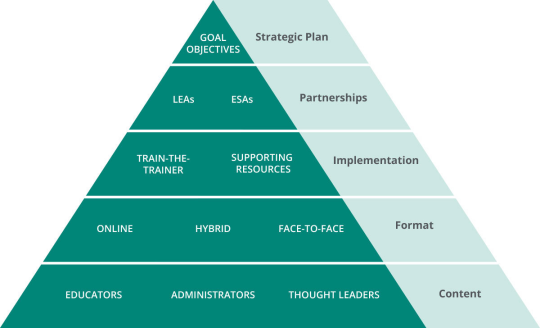Scaling Edtech Program Adoption
Date
Developing and growing a new program adoption or initiative in K-12 education is tough. It’s tough for curriculum development organizations, tough for Fortune 500 companies, and tough for consulting and professional service companies like us at Clarity Innovations. However, in our 25+ years, we’ve experienced some successes in scaling programs that we’ve been involved in. One such example was the Intel Teach program. The materials we created were used to train over 15 million educators worldwide. More recently, the web and iOS apps we developed for The Math Learning Center, are used nearly a million times every month worldwide.
“The most successful programs and organizations take a holistic approach to the K-12 education market that builds on the content and great ideas with varied implementation models and supports, strategic partnerships and go-to-market engines, and, last but not least, a strategic plan that sets achievable goals.”
Simply having a great idea for an app or a professional development program isn’t enough to guarantee success, though. Nor is bringing that great idea to fruition in the form of an app, book, or curriculum enough to make a difference on its own, either. Our experience shows these efforts are most successful when they take a more “holistic approach” and build on the content and great ideas with varied implementation models and formats, compelling partnerships, and an overall strategic plan that sets realistic goals that can be expanded over time.
The Program Scaling Pyramid
While taking a program from conception to successful implementation can require a lot of effort, thankfully, it isn’t too complex. Based on our work, we’ve identified five key components that provide a blueprint denoting the necessary conditions for a program to scale widely.

- Content. As the old saying goes, “content is king” and nowhere is that more apt than in the case of creating content for K-12 education. Moreover, content must be aligned to specific audiences (educators, students, administrators, etc.) and meet their needs in terms of standards alignment, scope and sequence, and instructional design or application.
- Formats. Long before the COVID-19 pandemic, developing and implementing materials in a variety of formats — from print to digital, face-to-face to fully online – has been essential for any program to scale. We’ve found this variety of delivery formats is essential because it provides more flexibility in terms of how our clients, their customers, and our clients’ partners can implement the programs we create. For instance, we’ve built professional learning offerings based on a 90-minute self-paced online format but to be successful and scale that same content needs to be made available as a 30-45-minute presentation (for, say, a school staff meeting) as well as a 3-hour workshop that a partner can sell. Although it may sound simplistic, all of these options provide just that…options to meet the needs of our clients’ customers.
- Toolkit. Although many software solutions and curricula come with “how-to guides” and “FAQs” most of those resources are designed for individual users. They aren’t designed for large training implementations by third-parties that the original developers may (or may not) know anything about. These sort of implementation toolkits (like a good Media Kit) provide all the materials a reseller, partner organization, or a school district’s own staff could need to train its users and implement programs with (or without) the publisher’s knowledge or active involvement.
- Partnerships. Rolling out any program in education, at scale, takes the work of a much larger group than most organizations have in house. As a result, the only way to be successful is to partner with others to help with marketing, dissemination, training, and implementation. For many of our clients who are relatively new to the more formal world of K-12 education, it is this area that is the most challenging. The alphabet soup of local, state, and regional agencies (ESDs, RESAs, BOCES, etc) and policy compliance requirements (FERPA, COPPA, Section 508 and 504, etc.) can feel like a byzantine landscape of bureaucratic obstacles to overcome. Finding a good partner to help navigate these complexities is essential to the success of a scalable adoption.
- Strategic planning. Strategic planning shouldn’t stop when a product is released for educators and students to use. Rather, that is the start of the next chapter of planning to determine the right approach to customer evaluation pilots, and data collection about the efficacy of your implementation plans. This is the opportunity to start identifying gaps and what accommodations to make for larger customer adoptions as your solution reaches more customers.
While there is no magic formula to ensure success, taking these elements into account puts you and your programs on a much more solid footing moving forward. Some, like developing high quality content, may seem rather obvious, but developing, selling, or even giving away a product to K-12 education can be very complicated. If you’re interested in learning more about how Clarity Innovations can help with this, please contact us.

